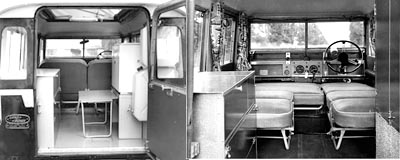
 |
OtherCurtains, misc. options and such |
Intro > Dormobile features > other options |
Cabinets | Seats | Refrigerator | Toilet | Badges | Exterior options |
|
Optional Air conditioning Martin Walter used an off the shelf air conditioning unit manufactured by Normalair. This unit was designed specifically for Land Rovers.
Optional Radio
Land Rover Dormobile option 1546 was a fully transistorised radio. This is a two band Radiomobile radio model 970 that was installed by Martin Walter Ltd. into a Land Rover Dormobile.
Optional second heater This heater was found in the center seat area of a 1966 Land Rover Dormobile.
The sheet metal enclosure encloses a hot water heater core and a flat fan. Hot water is plumbed from the front radiator. Three air vents are built into the seat box. One opens at the seatbox front to warm the driver's (left side) legs, the other two open at the rear of the seat box, aimed at the rear seat passanger leg area.
Original curtain fabrics Early Dormobiles: Cotton "mushroom coloured" curtain fabric. Late Dormobiles: Dynel fabric flame proof, fade resistant, soft pastel stripes (SIII) Silent Gliss hangers. Press studs on windscreen curtains to fit rake of windscreen and give more space.
The aluminium curtain track is visible plus the plastic curtain hangers. If you use your imagination, you can see the cotton string that is loosely strung at the top of the curtain and is used to hang the curtain from the plastic hangers. Note that the plastic hangers are two piece. One piece slides in the aluminium track. This piece has an eye that sticks out. The second piece hooks into the eye and has a hook that hangs down that holds the curtain. It is shaped vaguely like a tall skinny "C". The top is rounded and hooks into the eye. The bottom is less rounded and holds the string that is strung at the top of the curtain.
Curtain rods The aluminum curtain rods and plastic hangers were manufactured by Silent Gliss. Unfortunatly the product has been discontinued. however, according to Ian Kelly "There's a company called Recmar (www.recmar.com) that sells very similar tracks and fittings - and the sliders fit the Silent Gliss track. I believe also available from www.vintagetrailersupply.com"
More Land Rover Dormobile Features: Cabinets | Seats |
Refrigerator | Toilet | Badges | External
options | Kitchen |
Lifting roof |
Return to page top |
Return to Dormobile Introduction |
Return Home |
Copyright 1996, 2004 by John Hess, 2005 by TeriAnn Wakeman and John Hess All rights reserved
|